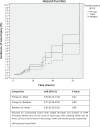Systematic rotation versus continuous application of 'nasal prongs' or 'nasal mask' in preterm infants on nCPAP: a randomized controlled trial
- PMID: 36967420
- PMCID: PMC10040306
- DOI: 10.1007/s00431-023-04933-1
Systematic rotation versus continuous application of 'nasal prongs' or 'nasal mask' in preterm infants on nCPAP: a randomized controlled trial
Abstract
To compare whether alternate rotation of nasal mask with nasal prongs every 8 h as compared to continuous use of either interface alone decreases the incidence of nasal injury in preterm infants receiving nasal Continuous Positive Airway Pressure (nCPAP). This was an open-label, three-arm, stratified randomized controlled trial where infants < 35 weeks receiving nCPAP were randomized into three groups using two different nasal interfaces (continuous prongs group, continuous mask group, and rotation group). All infants were assessed for nasal injury six hours post-removal of nCPAP using grading suggested by Fischer et al. The nursing care was uniform across all three groups. Intention-to-treat analysis was done. Fifty-seven infants were enrolled, with nineteen in each group. The incidence of nasal injury was 42.1% vs. 47.4% vs. 68.4% in the rotation group, continuous mask, and continuous prongs groups, respectively (P = 0.228). On adjusted analysis (gestational age, birth weight, and duration of nCPAP therapy), the incidence of nasal injury was significantly less in the rotation group as compared to continuous prongs group (Adjusted Odds Ratio [AOR], 95% confidence interval [CI]; 0.10 [0.01-0.69], P = 0.02) and a trend towards lesser nasal injury as compared to continuous mask group (AOR, 95% CI; 0.15 [0.02-1.08], P = 0.06). However, there was no significant difference in incidence of nasal injuries between continuous prongs versus continuous mask group (P = 0.60). The need for surfactant, nCPAP failure rate, duration of nCPAP, and common neonatal co-morbidities were similar across all three groups. Conclusion: Systematic rotation of nasal mask with nasal prongs significantly reduced nasal injury among preterm infants on nCPAP as compared to continuous use of nasal prongs alone without affecting nCPAP failure rate. Trial registration: CTRI/2019/01/017320, registered on 31/01/2019. What is Known: • Use of nasal mask as an interface for nasal Continuous Positive Airway Pressure decreases nasal injury as compared to nasal prongs. What is New: • Rotation of nasal prongs and nasal mask interfaces alternately every 8 h may reduce the nasal injury even further as compared to either interface alone.
Keywords: CPAP; Nasal injury; Nasal interfaces; Preterm infants; Rotation.
© 2023. The Author(s), under exclusive licence to Springer-Verlag GmbH Germany, part of Springer Nature.
Conflict of interest statement
None declared.
Figures
References
Publication types
MeSH terms
LinkOut - more resources
Full Text Sources
Medical



